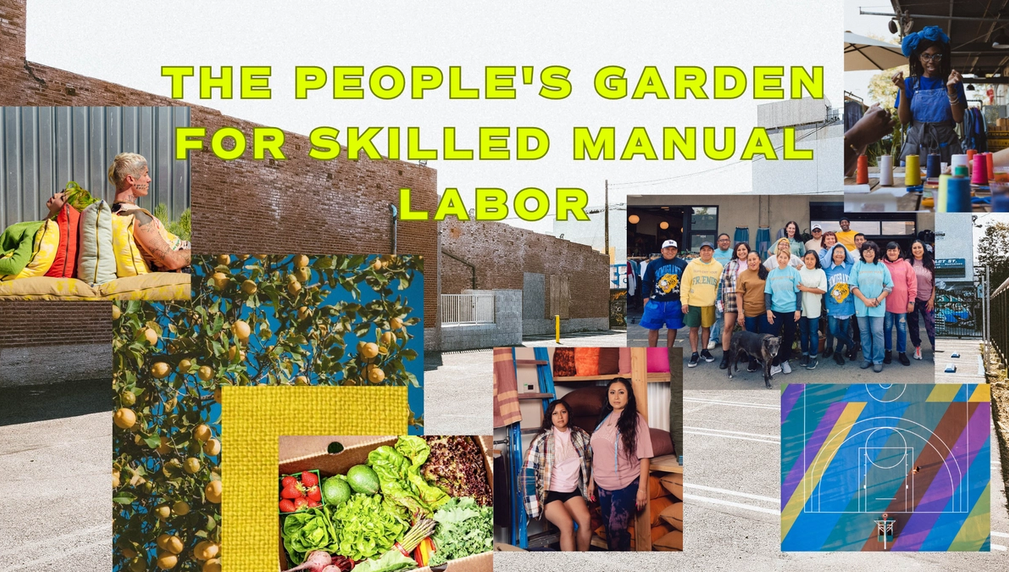The People's Garden For Skilled Manual Labor: A Green Cultural Space
Our vision of a more equitable, green Los Angeles goes beyond expanding the urban tree canopy. SUAY, with the active participation of the community, will transform a concrete-locked parking lot in Downtown LA into a vibrant, sustainable green space. This initiative will not only bolster climate resilience but also foster community, offering a shared space for recreation and nourishment. The impact on the community will be profound, enhancing the quality of life and promoting a sense of belonging.

What is the primary issue area that your application will impact?
Green space, park access, and trees
In what stage of innovation is this project, program, or initiative?
Pilot or new project, program, or initiative (testing or implementing a new idea)
What is your understanding of the issue that you are seeking to address?
Once a hub of economic success, Downtown LA faces challenges due to rapid urbanization compromising its environmental sustainability. Heat-producing materials and infrastructure have led to an urban heat island effect, raising temperatures and impacting human health. By mid-century, experts predict a temperature increase of 3°F to 5°F, with vulnerable populations suffering the most. Essential workers from diverse manual labor backgrounds are disproportionately affected. Transforming urban heat islands into green, sustainable spaces is crucial to protecting these communities and ensuring their survival.
In 2024, SUAY moved its headquarters to a historically industrial zone in the 90021 zip code, an area lacking nearby parks. The community has long sought more green spaces, but fears gentrification and the displacement of low-income community members. In Los Angeles County, nonwhite Hispanic and LatinX communities are growing, but there remains a racial disparity in access to parks.
Describe the project, program, or initiative this grant will support to address the issue.
The People's Garden For Skilled Manual Labor aims to transform SUAY's new headquarters in Downtown LA into a green oasis. We will create an edible urban orchard, a public art-filled basketball court, an amphitheater-style platform, and a native plant garden to address urban heat islands. This 12,000-square-foot space will become a multi-use Privately Owned Public Space (POPS), including outdoor exercise equipment, shaded areas, and a two-story mural. The garden will improve soil health, manage water run-off, and provide fresh produce to the community. SUAY aims to reduce green space disparities, enhance climate resilience, and foster community connectivity. The amphitheater-style platform will be a vibrant gathering space, culturally activated with music, performances, and community events. In the past seven years, we have worked with worker-centered organizations like The Garment Worker Center and NDLON. Through this work, we’ve learned that those most vulnerable to climate hazards have shared powerful stories of struggle and resilience. The garden will embody SUAY's original ethos of "know your grower, know your sew-er," engaging our 300K+ social following to visit the garden in LA and build a world-wide culture of community and reuse by supporting skilled laborers.
Describe how Los Angeles County will be different if your work is successful.
Our vision is to create a vibrant green space that enhances community life and the environment. Short-term goals include cultural enrichment, environmental improvements, and fostering mental well-being. Long-term goals include improving air quality, reducing noise pollution, regulating the local climate, mitigating flooding, and providing habitat for biodiversity. We also plan to organize market days for mutual aid and promote income and racial equity in green and sustainable spaces. Within the first year, we aim to collaborate with other businesses to create a democratic green grid across neighboring streets. The space will accommodate 4,800 individuals annually and provide walkable access to 1132 residents. Access to green spaces has therapeutic effects on mental health, alleviating chronic stress and anxiety, and potentially lowering mortality and morbidity rates from chronic diseases.
What evidence do you have that this project, program, or initiative is or will be successful, and how will you define and measure success?
The project aims to establish and track various data points across environmental, human health, and well-being performance benchmarks.
Environmental:
It is recommended to conduct an urban tree canopy (UTC) assessment every 5 to 8 years to measure coverage and growth.
The project will measure and track several climate objectives to assess the positive impact. Metrics will include energy efficiency, building heating and cooling usage/cost, average temperatures, carbon sequestration levels, and air pollution metrics.
Human/Social: Observational evaluations and surveys will be used to measure the social impact of the project, focusing on improving social ties, mental health, and overall sense of security among the community. Surveys will be distributed to the community within the area, and observational reporting may be implemented to capture usage metrics. Community feedback will be reviewed to identify opportunities for improvements in operations, maintenance, and design of the space.
Describe the role of collaborating organizations on this project.
The Center for Reuse + Repair will work alongside SUAY for strategic assistance and implementation of community programming that empowers garment workers. As a non-profit project, the extended team will network and fundraise to sustain the planned community-based services and events hosted within the garden space.
Approximately how many people will be impacted by this project, program, or initiative?
Direct Impact: 4,800.0
Indirect Impact: 24,000.0